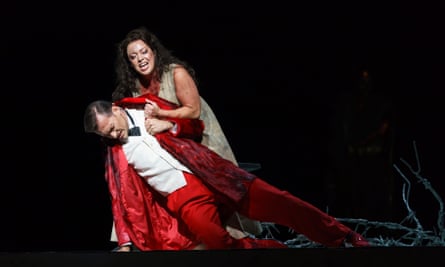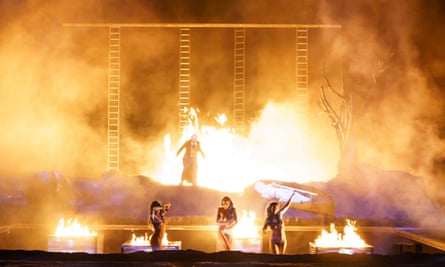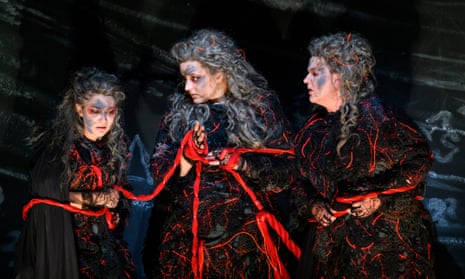At the centre of Götterdämmerung, the apocalyptic final instalment of Wagner’s Ring, there is a grand tableau: part recognition scene, part ceremonial set-piece, part showdown. As the tectonic plates of the plot crunch against each other, as the vast score solidifies into ever-more compacted strata of musical gestures repeated and transformed, beleaguered lovers air incompatible truths. What happens here sets in motion the machinery of the cycle’s catastrophic denouement.
In the Royal Opera House’s third revival of Keith Warner’s production the stage is packed – not, at last, with symbolic apparatus, but with the cycle’s only chorus: the men sinister in black leather, shades and gloves, their singing almost brutishly macho; the women still more disturbing as white-clad handmaidens, gestures compelling, largely silent. Captive in their midst, Nina Stemme’s Brünnhilde confronted Stefan Vinke’s Siegfried with a desperate power – raw, almost spoken at times – as Vinke’s hard-edged bluster sliced to the heart.

Watching them and slumped, faintly bored, in his wipe-clean Louis XIV armchair (no, I wasn’t sure why either) Markus Butter’s Gunther was slight to the point of being underpowered: certainly no match for an ex-Valkyrie. Stephen Milling’s Hagen, by contrast, was an awesome, overbearing presence both physically and vocally. Sensitive to minute changes in onstage atmosphere, the orchestra under Antonio Pappano was back on form, the brass a glorious alloy, woodwind solos liquid, the strings seamless from gritty to lush.
The scene was without doubt one of the triumphs of Warner’s Ring, its choreography tight, its symbolism (chairs notwithstanding) newly clear. In fact clarity was the watchword in this opera powered by plot recaps. Thus, the paraphernalia of Siegfried’s adventures in the previous instalment are laid out for him like a walk-through in a crime drama as he is slowly brought back to his senses. And the numerous red lines running through the cycle’s earlier operas turn out to be threads woven by the all-knowing Norns, magnificently sung here by Claudia Huckle, Irmgard Vilsmaier and Lise Davidsen.

There’s ultimately something rather Norn-like about Warner himself, obsessively joining dots and plotting lines across these 17-ish hours of mythological high drama. At times, the threads snap, or are too hard to detect in the first place, or are so densely tangled as to resist interpretation. But at his best Warner trusts in the communicative power of a fleeting physical gesture, and slows the torrent of significant objects to move human emotions back into the spotlight. Above all, just occasionally, he steps back – leaving the voices and orchestra to weave their own formidable spell.
The Ring Cycle continues until 2 November. The 28 October performance of Die Walküre will be live in cinemas.

Comments (…)
Sign in or create your Guardian account to join the discussion